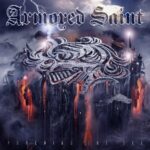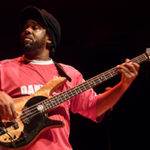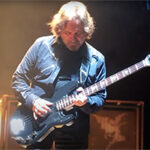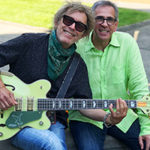Armored Saint bassist shares insight on balancing roles and the group’s long-awaited new album
Exclusive interview with FBPO’s Jon Liebman
June 14, 2021
Joey Vera is known for his masterfully idiosyncratic style of “pickless” bass playing. He’s also very adept at wearing a lot of hats. The L.A. native handles bass, as well as composition and production, for the heavy metal outfit Armored Saint, and also serves as the bassist for Fates Warning, Motor Sister and Pearl Aday. A veteran of the rock and metal scene, Joey’s worked over the years with Anthrax, Engine, OSI, Tribe After Tribe, and Seven Witches. Vera also led the prog-metal band A Chinese Firedrill and in 1994 released the solo album, A Thousand Faces. Armored Saint’s latest album, Punching The Sky, was released in October 2020.
FBPO: What’s the secret to 40 years of longevity for a band?
JV: [Laughs] Well, if I could answer that, I’d make a lot of money! I don’t really know. You have to define what that is, what success to you is individually, I suppose. I’ve been lucky to be around a lot of talented people and also a supportive situation, with people in my personal life and professionally. I’ve been able to stay in this business, as crazy as it may seem, for 40 years. One person’s definition of success is different from another, but I think that, as long as you as a person, as a musician, really enjoy and love what you do, then you are succeeding at it. No matter if you’re doing it in front of two people or 200,000 people, you’re doing it. That’s what success is, to suit to each person, I think. So, as long as you’re happy and enjoying what you’re doing, again, you’re going to succeed in doing it.
FBPO: Tell me about Punching The Sky. I guess you had a little more time than expected to work on it last year.
JV: Well, to be honest with you, as far as Armored Saint goals are concerned, we tend to be on this five-year cycle of releasing records, and Punching The Sky fits within that time frame. It’s really not by design necessarily, but it’s just the way it landed. We began tracking drums in December of ‘19. The record was already done by the time COVID hit us all. We kind of dodged that bullet, as far as our working pace was going. I’d say it takes us about 16 to 18 months to write a record. Then we have some pre-production and recording, and that lasts about another four to five months total. We were just beginning the mixing stage in March of ‘20, so we were technically already done making the record. The mixing stage began right during lockdown, which of course is easier to deal with because we share files and approvals over emails, so it wasn’t like it really affected us. We were done mixing in April of ‘20, and then the record came out in October.
FBPO: Conceptually, it’s always felt right to me to lay down the drums, then the bass, then everything else. You like to do the opposite.
JV: Yeah. I prefer to do my bass parts later in the sessions. I demo the music before we actually get to the pre-recording phase. I have played bass on the demos and I’ve figured out what the bass parts are going to be, but when it actually comes down to recording the record, typically, the last couple of records with Armored Saint, we’ve been using Pro Tools, and using the demo sessions as kind of a skeleton for each song. Once we begin rebuilding, we put the drums first, and then we use the bass from the demos as a scratch track for the rest of the guys. If it sounds good to me, I make a call and say, “Well, that sounds great. I don’t need to redo that.” But if I want to change the sound or I modify the part, then I will replay it, so I can play my bass at the end and not step on anybody else or get in the way of certain things rhythmically that are already there.
FBPO: How do you balance all the hats you wear: producer, composer, bass player…?
JV: I just think it depends on what situation I’m in. I’ve been very fortunate to be involved in a lot of different things and have had different roles. I’ve learned over the years how to participate in a group and how to recognize what my part is in this play or on this team. I think it just comes through practice, by being thrown into situations that are sometimes outside of your box, and sometimes challenging, with a lot of variety, a lot of different personalities. You just learn where your place is. Sometimes you’re asked to speak up, sometimes you’re asked not to speak up. In doing all that, you gain the knowledge of how to just jump from, as you say, from wearing one hat to the other. Along the way, I’ve garnered an interest in being a leader in those senses, being someone who makes decisions on the production, or songwriting, or any kind of participation, when it comes to a band.
FBPO: It’s also a sign of having a lot of personal security.
JV: Absolutely. It’s true, and it’s not an easy thing to do. I mean, I’m human. I still struggle with ego myself. I fully admit that, but I think it takes practice. It takes practice leaving your ego at the door, and eventually you get better at it. And then you find that you become a very valuable asset when you’re able to do that because you can kind of morph into every situation and be able to be an ally or an asset within those situations. I think that every musician would benefit if they could do that because you want to be an asset to every situation you go into. You don’t want to be a liability.
FBPO: Let’s talk about your bass technique. You have a way of moving your hand up and down that’s somewhere between double thumbing and using a pick, though it’s actually neither.
JV: I do it seldomly, but it does come from being a guitar player. I learned guitar first. I probably only played guitar for maybe two years, and then I switched to bass when I was 15 or 16. For the first six months or a year of playing bass I did play with a pick, but I switched over to fingers fairly young and fairly early. I pretty much only use my index and middle finger. I never use my ring finger. Period. I do use my thumb as you pointed out, mostly for popping and slapping. Sometimes, you kind of place your thumb and your forefinger together as if you’re holding a pick. But there’s no pick there. So, it’s an invisible pick. That way, you can strum the string up and down, but the thumb catches the string on the downstroke, and the forefinger catches it on the way back up. So that’s, in a sense, the pick. You’re using your fingers as a pick, but there’s no pick there. I don’t do the Victor Wooten, Marcus [Miller] thing, where the thumb goes down and the thumb comes back up. I’ve been practicing that but I’m just not very good at it. So, when I’m popping or slapping a triplet, I tend to use a cheat method of thumb down, dead string on the left hand, then pop the forefinger on the right string. That’s how I “cheat” my triplets.
FBPO: I wouldn’t call that cheating! Tell me about your gear.
JV: My gear changed over the years. For the last 10 years or so, my live rig has been Hartke. I’ve been using the LH1000s with the HyDrive cabinets. I use 810s. That’s basically the power stage when I’m performing live. I’ve also been using Tech 21 for many, many years. Various versions of their SansAmp have been part of my setup. That’s pretty much in the front end of the rig. That goes into the back of the HL1000 from Hartke. I go into the effects return, kind of bypassing the preamp stage, using the power stage of the Hartkes. Hartkes are super, super clean power stage, and just have tons of headroom. It’s a 1000-watt head so it’s pretty awesome when I use it this way! That’s typically the bare bones of it.
FBPO: Do you use different rigs for different bands?
JV: I have different setups between Fates Warning and Armored Saint and Motor Sister, for instance. Sometimes, I’m using different effects and things like that, but that’s the bare bones of it when it comes to live.
FBPO: How about in the studio?
JV: In the studio, it’s completely different. I don’t use any amps lately. I’ve been only going DI. Probably a little bit overkill, but I’ll do lots of different splits on the tracks. I’ll do a clean DI that’s basically straight, coming off the guitar, and then it’ll be various things. One is the VT Bass, the Tech 21. Sometimes, I use an RBI, which is also a Tech 21, the Rackmount version. Lately, I’ve been using Darkglass, the X7, which is super nasty, distorted, just completely dirty and nasty. It takes a while to use these three different things. I’ll flip phases on a couple of tracks to get basically the tonality that I’m looking for, but it kind of gives the mixers and the engineers a lot of variety in the end to work with.
FBPO: What about basses and strings?
JV: Basses, I’m with ESP. Been with them for also about 10 years. I’ve been using, most of the time, their Vintage 4s, which weren’t available for a while, but they reintroduced the Surveyors, which they originally put out in ’87. It’s a P-bass-style body, basically an alder body, very, very, very similar to Fender P Basses. I have PJ setups that I get from EMG. Have been using EMGs forever too. I use the EMG Xs, the PJ models. I have several 4-strings, B-4 versions, but I also have a custom 5-string that I use from Japan. I use DR strings, Hi-Beams. Been with them forever as well, since 1990, 1991. Amazing strings. I use Babicz bridges, Full Contact Hardware. Super amazing stuff.
FBPO: What advice could you impart to somebody who wants to learn to play bass?
JV: Well, I can only go by my experience, really. The way I learned when I was a teenager was listening to records and trying to mimic what I was hearing. I think that that comes from a place of joy because when you’re young and impressionistic, you’re excited about your favorite bands and music that you like. That helps you get motivated, obviously, to do things, and if you choose to play an instrument, that’s what you’ll do. So, that’s what motivated me, taking some of my favorite songs of my favorite bands or players, listening to the parts and trying to imitate them.
FBPO: Who were you listening to?
JV: Well, for me, growing up in the ’70s, it was pretty wide, a variety of things. I was listening to the Beatles. I was listening to Kiss, Cheap Trick. I was listening to Queen. I was listening to Earth, Wind & Fire. I was listening to The Brothers Johnson. I was listening to Sly Stone. I was listening to Black Sabbath, Led Zeppelin, Deep Purple, Aerosmith, a pretty wide variety of things. Those are the things that I gravitated towards. For me, it was Geezer Butler, it was John Paul Jones, John Entwistle from The Who, Verdine White, Louis Johnson. Some of these guys were beyond my reach when I was first learning, but if I could fake my way through “Shining Star,” I’d be excited! I think, a large part of this comes from your joy about just listening and listening to your favorite bands and using your ear to try to learn and mimic what you’re hearing. Eventually, you’ll figure out where the G note is, and where the A note, and where the D is, and the F. You’ll see that and you’ll relate it to other songs that you listen to. But if you want to go further, it would benefit you to understand at least some theory. You’ll see how things are connected, and why they’re connected, and how they make sense. Going to sites, such as this site, will benefit you to absorb as much of that theory as possible. It’ll make sense to you. That in itself makes you more excited too.
FBPO: What else is keeping you busy these days?
JV: Well, music, and getting ready to go on the road. I’m starting to look forward to getting back out and playing again in front of people. I just finished working on a live DVD with Armored Saint. We recorded one of our records called Symbol of Salvation, which came out in 1991. In 2018, we toured and recorded the whole record in its entirety and videotaped the show. We just finished working on that packaging and everything. So, that’s finally in the can and it should be coming out in October. Armored Saint also has a new production video for a song called “Lone Wolf,” which is on Punching The Sky. That’s coming out at the end of July, so that’s exciting. Getting ready to do some dates at the end of the year with Armored Saint. It’s both exciting and scary at the same time. Also, the Motor Sister record is all done and mixed and we’re getting ready to do the packaging for that. I got to start picking my bass up because, I have to be honest, I haven’t been playing it much. I’ve been so busy with kind of tech stuff with mixing and overseeing editing and stuff, I haven’t paid much attention to playing. I miss my basses so I got to go back and start playing again.
FBPO: What would you be if you weren’t a bass player?
JV: I would probably still be in the arts because I grew up around art. My dad was a graphic designer and I’ve always been around art. I’d probably be more involved in film or photography or videography. I have dabbled in it along the way.
See Jon’s blog, with key takeaways from this interview here.
Armored Saint’s latest album, Punching The Sky, is available here:








